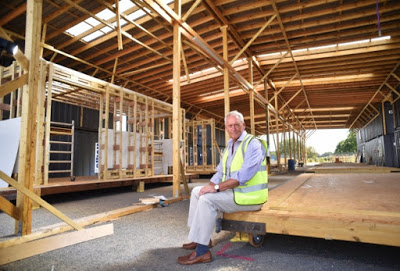One way to cut costs and at the same time provide local solutions to the problem of affordable housing to areas is to build “pop up” modular home factories that build module after module, ship them a short distance to the job site and then closed down with the equipment being reused at a new ‘pop up’ factory.
As a technique, modular, or volumetric construction, is particularly well suited to high-volume, repetitive components, or products that require factory conditions to achieve the desired level of quality. It can also allow parallel working on different aspects of a project simultaneously.
 |
| Beattie Passive chairman Ron Beattie |
Britain’s Beattie Passive, based in Norfolk at Hethel Engineering Centre, has designed a “flying factory” which can be used to build volumetric, or modular, homes.
And not just any ‘flying or pop up’. The homes produced in this factory will be Passive and built by local agencies serving the area. The company will provide knowledge and support to help these agencies and non-profit organizations run the factories, plus a blueprint for their construction. Local labor will staff the factories and will be provided with training in volumetric engineering by Beattie Passive in an attempt to ease construction labor shortages.
Related Article: Is the Pop Up Factory the Future of Modular Housing
They are different from conventional off-site factories in that they only operate for the duration of a project and are then closed.
Flying factories have the advantage of being able to locate close to, or even on construction sites, or close to sources of materials and so reduce transportation costs, disruption and delays. It can also be more flexible, as leases or buildings are temporary, and so facilities can be scaled up or scaled down to suite the demand from a particular project.
Ron Beattie, who founded the company with wife Rosemary, said it was a “whole new venture” for the growing firm.
“Construction is changing. We need to find new ways of delivering homes, we cannot do it the old way and with young people not wanting to come into the industry it is struggling,” he said.
“Flying factories have been around for a while but now we need to do more off-site. We have got volumetric factories which can build units, transport them and put them up in a day.”
Beattie Passive will supply everything from the engineering to factory management while local organizations will get training on how to manufacture the modules. Beattie Passive has been a leader in providing instructors and classroom training for new hires which gives them a better workforce. Real training was recognized by the company as a cornerstone for future growth.
The big question is “Will this work in the US?” The answer is easy….YES!
Will any modular factory or large offsite builder step forward to do it within the next 5 years? Now that is a question that may not have an answer.























